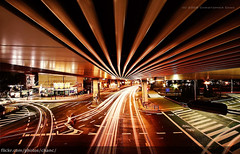 In Jade Simmon’s discussion on the necessity of rhythm in human interaction to the Brittain Fellows on Monday, October 10th, I was reminded of a Radiolab podcast from a while back on how two physicists explained the nature of urban life based on the rhythm created by its inhabitants. For Radiolab newbies, this NY-based NPR show reports on the intersection between science, philosophy, and society. In this specific episode, the show discussed how these two scientists measured the number of footsteps of inhabitants per unit of time and found that each city formed its own unique rhythmic beat. The scientist then hypothesized that there is a correlation between a city’s unique beat and its living conditions, for example the number of libraries, the crime rate, even the number of disease incidents per year at a given city. When they finally compared these beats among various cities, they concluded that these living conditions, including the unique beats produced, were determined by a city’s size. In other words, size was the largest determinant of a city’s living conditions, including the average walking rhythm of its inhabitants. Several months after Radiolab aired this report, the New York Times Magazine also composed a piece (titled “A Physicist Solves the City“) on the two scientists involved in this research. Rhythm, apparently, is somewhat infectious.
In Jade Simmon’s discussion on the necessity of rhythm in human interaction to the Brittain Fellows on Monday, October 10th, I was reminded of a Radiolab podcast from a while back on how two physicists explained the nature of urban life based on the rhythm created by its inhabitants. For Radiolab newbies, this NY-based NPR show reports on the intersection between science, philosophy, and society. In this specific episode, the show discussed how these two scientists measured the number of footsteps of inhabitants per unit of time and found that each city formed its own unique rhythmic beat. The scientist then hypothesized that there is a correlation between a city’s unique beat and its living conditions, for example the number of libraries, the crime rate, even the number of disease incidents per year at a given city. When they finally compared these beats among various cities, they concluded that these living conditions, including the unique beats produced, were determined by a city’s size. In other words, size was the largest determinant of a city’s living conditions, including the average walking rhythm of its inhabitants. Several months after Radiolab aired this report, the New York Times Magazine also composed a piece (titled “A Physicist Solves the City“) on the two scientists involved in this research. Rhythm, apparently, is somewhat infectious.
A Note on “Rhythm as Necessity”
Share articles with your friends or follow us on Twitter!
Bookmark the permalink.
